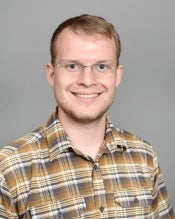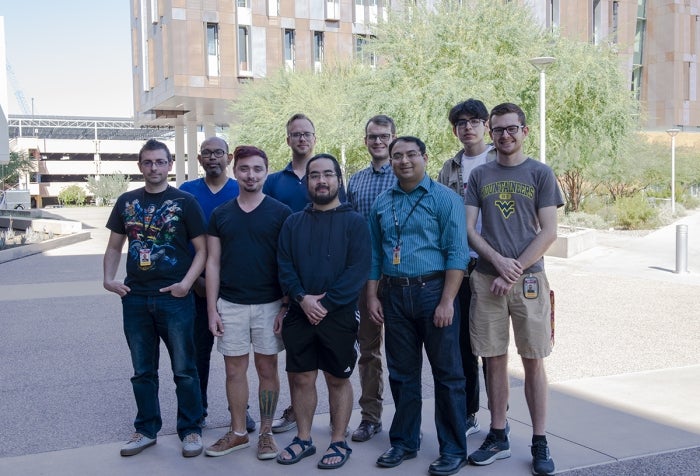PhD grad honed interdisciplinary skills at ASU

James Turrell’s Skyspace: Air Apparent on ASU's Tempe campus. Graduating student John Vant says it was his favorite place to study during college.
Editor’s note: This story is part of a series of profiles of notable spring 2024 graduates.
Models and simulations aren’t just “pretty movies,” according to John Vant. They can have a significant impact on serious problems. Graduating from Arizona State University with a PhD in chemistry, Vant is now headed to Oak Ridge National Laboratory, where he will build models to enhance radiation therapy, which is used to treat more than half of all cancer patients.
Vant was attracted to ASU for its emphasis on collaborative, interdisciplinary research. His academic odyssey was guided by mentors like Austen Angell, whose seminar course illuminated the importance of effective research communication.
Vant’s academic journey intersected with the Biodesign Institute, where he found a supportive environment for his burgeoning scientific endeavors. Under the mentorship of Abhishek Singharoy, he delved into integrative modeling, a pivotal aspect of his research, while immersing himself in the vibrant research community at Biodesign.
Throughout his tenure, John secured prestigious fellowships, honed his research skills and found a sanctuary for contemplation amidst the serene surroundings of James Turrell’s Skyspace: Air Apparent.
Here, Vant shares insights and experiences from his time at ASU.
Question: What was your “aha” moment when you realized you wanted to study the field you majored in?
Answer: I realized I wanted to pursue a PhD in chemistry when I took statistical mechanics courses with Professor McRae at Eastern Washington University. His course equipped me with the necessary language and mathematical tools that helped me ask deep questions related to the fundamental underpinnings of the material world and life itself.
Q: What’s something you learned while at ASU — in the classroom or otherwise — that surprised you or changed your perspective?
A: During my time at ASU, I gained a wealth of knowledge in various scientific subjects. However, one of the most valuable skills I acquired was the ability to communicate my research effectively through writing. I learned how to structure scientific writing by understanding the different rhetorical moves. This helped me digest technical manuscripts more easily and craft more effective written pieces. Additionally, I developed skills in creating presentations and posters tailored to specific audiences, which has been beneficial in sharing my research with others.
Q: Why did you choose ASU?
A: I was accepted into several PhD programs but chose to attend ASU because of its emphasis on interdisciplinary science. The chemistry department at ASU, called the School of Molecular Sciences, reflects this focus. To make significant advancements in science, researchers from various backgrounds must collaborate to expand the limits of human knowledge.
Q: Who taught you the most important lesson while at ASU?
A: During my first year of PhD, I took a seminar course instructed by the late Austen Angell. The course was based on student presentations, and I received valuable feedback from Professor Angell. While presenting, I emphasized the quantitative results of my biomolecular simulations, calling them “not just pretty movies.” However, Professor Angell reminded me that one of the strengths of my work was its potential to inspire new hypotheses.
Q: How did you end up working on a team that is part of the Biodesign Institute?
A: During my visit to Arizona State University as a prospective student, I met with Abhishek Singharoy to discuss his laboratory and research. The opportunity to work as a theorist in the Biodesign Center of Applied Structural Discovery alongside experimentalists was extremely appealing to me. Integrative modeling is a significant part of my research, and understanding the data I would be using in my simulations would help me increase the impact and relevance of my work.
Q: How did the time you spent in your role as part of the Biodesign research community prepare you for your career?
A: While working with the Biodesign research community, I was fortunate enough to receive fellowships, conduct independent research, write manuscripts and push the limits of my understanding. The community greatly facilitated these endeavors, which not only helped to bolster my CV but also helped me gain confidence in my abilities and research.
Q: What’s the best piece of advice you’d give to those still in school?
A: The most valuable advice I can give students is to pursue research that interests them. Curiosity and determination can be a guiding light when things don’t go as planned. You can make great strides if you’re willing to be wrong and relentlessly pursue the causes.
Q: What was your favorite spot on campus for studying, meeting friends, or just thinking about life?
A: My favorite spot on campus is Air Apparent by James Turrell. It’s a beautiful area filled with various unique desert plants. The space is perfect for relaxing, reading or taking a break from lab work. The shade provides a comfortable environment, especially after long hours of sitting in the lab.
Q: What are your plans after graduation?
A: I have begun a postdoctoral position at Oak Ridge National Laboratory, where my work will focus on building models to enhance radiation therapy and to understand its impact on the human body.
Q: If someone gave you $40 million to solve one problem on our planet, what would you tackle?
A: If given $40 million, I would invest it in educational programs for K–12 schools. Humanity faces numerous challenges, but we can confront and overcome them with the hard work of current and future scientists and engineers.
More Sun Devil community

ASU student, Navy vet pursues greener future in sustainability
As Arizona State University holds its annual Salute to Service celebration, honoring individuals who serve the nation and their communities, Shana Harly stands out for her commitment to both her…

No limits to a mother’s love, a wrestler’s determination
Judy Robles was washing dishes in the kitchen of her California home and keeping an eye on her young son, who was playing in the park that backed up to the house.She looked down for a second, maybe…

A symphony of service: Iraq War vet and ASU alum finds healing through music
At the age of 30 and only one credit away from obtaining his bachelor’s degree in piano performance, Jason Phillips could no longer stifle the feeling that he was stuck. He was teaching at a…

